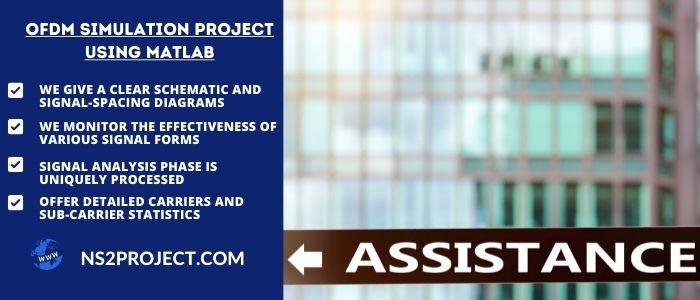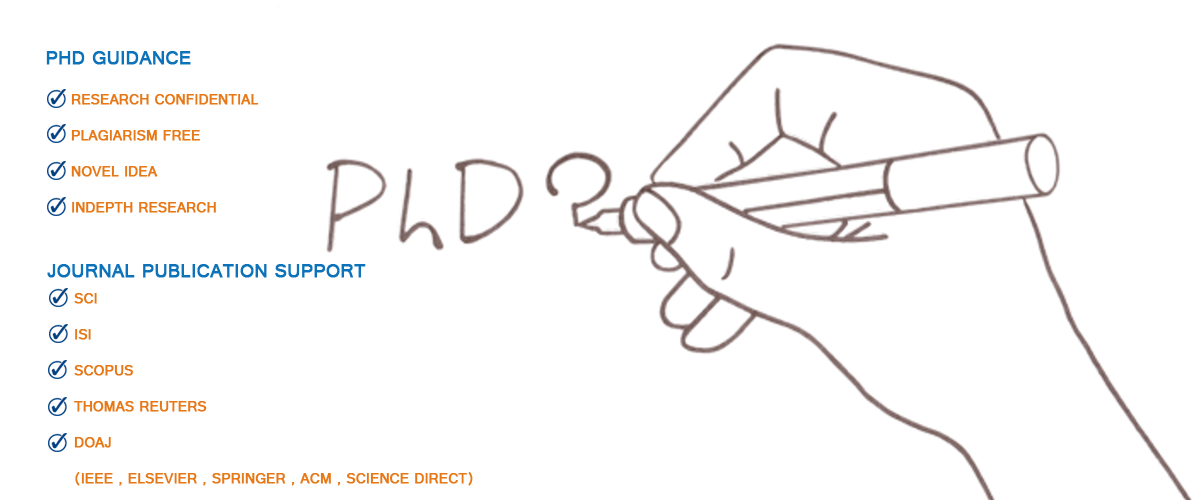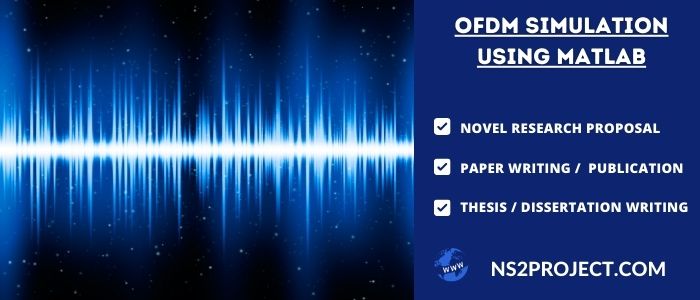The word OFDM refers to Orthogonal Frequency Division Multiplexing (OFDM), which is a wideband modern digital technology with multiple carriers. Mobile networks, 4G, wireless connections, digital television, power cable channels, and DSL are examples of current communication systems that employ OFDM.
“This article is a complete picture on OFDM simulation using MATLAB.”
Let us first start with the working principle of OFDM,
What are the working principles of OFDM?
The major principle of operation for OFDM is as follows,
- Maintaining carrier orthogonality is the most important component of OFDM
- When the integral of the combination of two signals equals zero over the duration, the signals are shown to be orthogonal
- This criterion can be satisfied by two sinusoids having a fundamental frequency
Let us know talk about the major characteristics of OFDM,

Key features of OFDM
The following are the key features of OFDM
- The data is carried on parallel streams by a significant number of densely packed orthogonal carriers
- For a fixed bandwidth, reduced symbol rates yet obtaining the very same rate of data
- Because of the slow symbol rate, it is necessary to remove intersymbol interference (ISI) by incorporating a guard interval
- Co-channel interference in narrow bands is not a problem and is also ISI-resistant
- Due to the advantages of the IFFT and FFT, there is a lower operational cost
- In comparison to several other spread spectrum approaches, this method increases spectrum utilization
These OFDM features make it the most significant in wireless communication. Let us now look into the steps involved in generating OFDM signals
How OFDM signal is generated?
- Multiple consecutive tones or subcarriers get modulated using complicated data separately in the frequency domain
- The OFDM symbol in the time domain is created by performing an Inverted FFT transform on the subcarriers in frequency-domain
- To achieve the complete OFDM burst signal, many symbols can also be concatenated
In the next section, we have given the major steps involved in the OFDM signal generation process. But before understanding the steps, we need to note the PHY info of OFDM. It consists of the following aspects,
- 48 data, 52 subcarriers (one subcarrier equals one constellation point)
- BW is 20 Megahertz and OBW is 16.6 Megahertz
- Four pilot and 312.5 Kilohertz of carrier separation
The following are the significant stages involved in the generation of OFDM signals,
- Input data in the form of bit stream is at first encoded
- It then interleaves, gets grouped and mapped onto constellation
- In constellation mapping, the data is first mapped to OFDM subcarrier and then FFT bin is filled for 52 times
- Therefore loading 52 complex measures into FFT frequency bins is the next step
- Then subcarriers are converted into time domain using IFFT
- Guard interval is then added where baseband signals are sampled at 20M samples per second
- It is then transmitted as a single symbol
- The same process is repeated for new symbols
- Finally the symbols are added to the preamble and concatenation of symbols to one time domain burst signal is done
In these stages, there are research issues that are unique to each application. Our engineers are experts at OFDM Simulation using MATLAB to solve both common and unique research problems related to OFDM simulation. Researchers seek expert assistance in achieving their research objectives through the use of appropriate simulation platforms.
Let us now see some of the major OFDM research issues below
Research Issues in OFDM Simulation Using Matlab
OFDM research challenges are mostly caused by the limits listed below.
- Owing to the guard interval, there is a decrease in efficiency
- Peak-to-average power ratio is extremely high
- Responsive to Doppler shift and frequency synchronisation
As a consequence of higher sensitivity inter-channel interference, the following observations on OFDM issues can be made,
- Frequency, clock, and phase offset all affect the performance of OFDM
- The peak-to-average ratio of the OFDM time-domain signal is relatively high
- It minimizes the RF amplifier’s power efficiency
- It also causes non-linear amplification to damage the OFDM signal’s orthogonality, resulting in out-of-band radiation
- Large dynamic ranges are required for lower noise receiver amplification
- Because of the guard interval, capability and energy are lost
- The guard interval could result in severe bandwidth and loss of power
Data is broadcast in parallel throughout the multiple carriers inside the entire OFDM signal in almost any type of OFDM. The total data rate is the same as the original data stream, but every substream will have a much-reduced data rate, and the symbols are spread out even further in duration. Let us now understand the reasons for using OFDM,
Why Use OFDM?
Several modern communications technologies incorporate OFDM as a strategy. OFDM has several advantages, including the following
- Enabling for separate channel estimation and equalisation at every subcarrier
- High total spectral frequency and flexibility of resource sharing in several data streams
- Frequency selective fading and multi-path abnormalities in wideband networks are overcome
- As each subcarrier undergoes flat fading, equalisation involves just one tap per subcarrier, making it compatible with MIMO and Massive MIMO networks
For these reasons, OFDM is highly significant these days. We are very much skilled, experienced, and highly knowledgeable in OFDM. You can get all kinds of technical support from our research experts. We are here to support you throughout your research.
Usually, we provide our customers with detailed, simple, and practical explanations of OFDM principles. We have over 15 years of expertise in guiding OFDM Simulation using Matlab research. Our highly qualified engineers have obtained world-class accreditations. As a result, we can give you all of the essential assistance in OFDM modeling research and drafting proposals, summaries, thesis, and papers.
In this respect, we have given the detailed description of the working of OFDM below,
How Does OFDM Work?
The OFDM transmission method is composed of many different parts
- The information must be coded and modulated, most commonly into QAM symbols
- In order to turn the signal into orthogonal overlapping sinusoids (in the time domain), these symbols are fed into frequency bins (evenly spaced). An Inverse Fast Fourier transform (or IFFT) is used for this purpose.
- Every OFDM symbol is further given a cyclic prefix
- It provides for circular convolution to be computed using linear convolution
- This happens when the cyclic prefix lengthy as network impulse response
- This enables receiver equalisation for minimising the intersymbol interference
- It is executed using a simple complex scalar multiplication addressed to every OFDM symbol separately
With references from advanced research articles, books and journals we will provide you with all previous, current, and future research ideas in OFDM. Along with these we also provide the technical note on working of various projects. Sticking to this point we now give you a short note on OFDM simulation working
How does OFDM simulation works?
The following are the steps involved in OFDM simulation
- Under AWGN channel, OFDM is modeled with QPSK, M-PSK, QAM, and BPSK
- Test Simulation is then performed
- BER performance is checked for various modulation schemes
- Finally performance analysis is carried out and SNR, BER performance is compared with the simple explanations of our research team, you can get an even more enlarged picture of working OFDM simulation.
Let us now talk about using MATLAB for OFDM simulation,
Process for simulating OFDM transmission using MATLAB
- Data input is sent for coding and modulation
- Data is then converted from serial to parallel
- By the addition of pilot symbols into IFFT, the data is then forwarded here
- Again a conversion from parallel to serial form is performed
- With the addition of a cyclic prefix, the data is finally sent to the receiver
From these points can be easily understood that gaining expertise in all MATLAB functions associated with OFDM Simulation is more important for research in the field. We are here with all the necessary data experience and knowledge to guide you. Let us now look into some communication standards that prominently use OFDM
What are the standards uses OFDM?
- IEEE 802.11g for Wi-Fi (at 2.4 GHz)
- IEEE 802.11j for working of WLAN (at 4.9 to 5 GHz)
- IEEE 802.11p in operating DSRC (at 5.9 GHz)
- IEEE 802.11a for operating Wi-Fi (at 5 to 6 GHz)
- Other IEEE or Cellular Bands (at LTE / LTE-A / 5G / 5G beyond and 6G networks)
The OFDM simulation using MATLAB and all our wireless Communication Projects may be viewed in two dimensions: 2D and 3D. Apart from that, OFDM employs 16QAM, 64QAM, 256QAM, and other modulation schemes. Ultimate research supports for all new topics are now available with us. Let us now see the best OFDM research topics.
Research Areas in OFDM
The following are the major OFDM research areas
- Fiber optics, visible light, optical and optical wireless communications
- Massive MIMO, MU – MIMO, Visual MIMO, and CO – MIMO communications
- Machine type and device to device communications
For project and research support on these topics, you can directly contact us. We will provide you with the necessary research data to help you in choosing the best topic for your research. Let us now talk about few prominent research areas in OFDM simulation using MATLAB,
Research Ideas in OFDM using Matlab
- Initial Ranging Parameters Estimation
- Resource Allocation and Sharing
- Multiple Antennas Selection
Presently, we provide detailed research assistance in all of the areas listed. You are free to discuss with us if you have any additional novel proposals. With us, you’ll have a more enjoyable research career. Let us now see different OFDM modulation methods,
OFDM Modulation Techniques
- At a lower symbol rate, every subcarrier is modulated using a traditional modulation strategy
- Phase Shift Keying
- Quadrature Amplitude Modulation
- In the same bandwidth, this keeps overall data speeds comparable to Single-Carrier Modulation Techniques and also Multi-Carrier Techniques
Limitations of OFDM modulation
- The capacity of OFDM to withstand very harsh channel circumstances like attenuation of high frequencies inside a lengthy copper cable, narrowband distortion, and frequency-selective fading caused due to multipath without complicated equalisation filtering is its major benefit
- Lesser effective modulation schemes (like QPSK) does not demand a large Signal to Noise ratio and doesn’t provide large bit rates
- At greater SINR, higher bit rate could be attained
- The local oscillator frequency and carrier transmission frequency must be precisely matched in order for OFDM to work
- Crosstalk among the channels and a higher number of mistakes will ensue if this is not done
OFDM modulation can be useful in the following technologies,
- Broadband digital systems such as LTE simulation, ADSL and VDSL – mobile broadband internet access methods
- Applications that are point-to-point or point-to-multipoint
- DVB-T, DVB-H DVB-T2, T-DMB I ISDB-T terrestrial digital video broadcasting, Wi-Fi IEEE 802.11a and 802.11g networks and Power Line Communication (PLC)
Technical guidance on these standards and associated algorithms will be provided by us. Apart from these modulation techniques, there are some advanced schemes developed for OFDM modulation as given below
Advanced modulation for OFDM Wireless Communication
- SM – OFDM and OFDM – DMIM
- Adaptive power and intensity modulation
- GSFIM, M-QAM and STSK
We have also worked with all these advanced modulation techniques. The list and technical details of all our successful OFDM projects can be a better help for your research. Let us now talk more about the modulation functions in OFDM
OFDM Modulation Functions
- Analogue baseband modulation techniques include methods for deviation and modulation of frequency and also it Analogue passband modulation covers phase modulation, Amplitude Modulation (or AM) and Single sideband AM
- Digital baseband modulation includes PAM, QAM, APSK and MSK
You can better compare these modulation functions using the analytical data provided by our experts. So reach out to us for more details on these modulation functions. Let us now look into MATLAB toolboxes for OFDM.
MATLAB Tools and Toolboxes for OFDM
The following are the important MATLAB and Simulink toolboxes useful for OFDM Simulation
- WLAN toolbox
- LTE toolbox
- 5G toolbox
- Communications toolbox
OFDM signals can be designed and tested directly using the blocks and functions provided by these toolboxes. You can also use MATLAB to explore all toolboxes, data sets, and simulation capabilities for whatever feature of the OFDM simulation you need. As a result, you can use the MATLAB platform with confidence to simulate your OFDM projects. Let us now look into the significance of Simulink and MATLAB for OFDM projects
What are the purpose of Matlab and Simulink for OFDM?
- Develop, analyze, and simulate OFDM waveforms at the link level
- To improve performance, create and optimise digital, analogue, or hybrid beamforming techniques
- Analyze measures including connection efficiency, stability, channel estimates, and equalisation by incorporating OFDM into your wireless proposed system
- With the Wireless Waveform Creator app, users could model OFDM waveforms for simulation or over-the-air verification
- With the Wireless HDL ToolboxTM, you can create OFDM wireless communication systems with HDL code creation and hardware implementation in mind.
- Specific functions can be called to create OFDM waveforms that are designed for specific quality standards.
- Using functions and blocks, you may customise OFDM characteristics including learning signal, zero padding, and cyclic prefix
- With the Wireless Waveform Creation Generation, users could model incorporates OFDM waveforms for simulation or over-the-air verification.
- With the Wireless HDL Toolbox, you can create OFDM wireless communication systems with HDL code creation and hardware implementation in mind
For these reasons, MATLAB is considered an undeniable choice for OFDM project simulation. In this regard, it is quite important to understand the parameters for OFDM simulation as given in the following
Parameters for OFDM Simulation
The numerical variables must be in powers of two since the IFFT and FFT are used. The following are the specified parameters for generating the sequences and the OFDM system.
- Size of bit sequence and FFT size with respect to the subcarriers
- ADC digital levels and frequency sampling measured in hertz
- Samples per symbol for analogue signal simulation
- Types of amplitude and phase modulation like BPSK, 64QAM, QPSK and 16QAM
- Duration of cyclic prefix, FFT and Prefix length
- Number of subcarriers, virtual subcarriers and BER target
- QAM and PAM constellation sizes, modem and channel
- Clipping ratio, OFDM, echo delay and AWGN
- Oversampling, transmission power and shape of the pulse
Considering these parameters OFDM simulation is carried out using software like MATLAB. Our technical team has extensively used MATLAB for multiple projects. So we are ready to provide you with any kind of assistance regarding the use of MATLAB. The following is a quick note on our OFDM simulation using MATLAB project support
What we provide for OFDM simulation Project?
- For the intended concept, we give a clear schematic and signal-spacing diagrams
- We monitor the effectiveness of various signal forms and signal strengths
- The signal analysis phase is uniquely processed for all projects by our experts
- For any and all tasks, we assess the model complexity and offer detailed carriers and sub-carrier statistics
Anyone performing OFDM research faces a lot of associated problems. But you need not be alarmed. Because you’ve just discovered the world’s leading, reliable, and skilled research assistance to implement OFDM Simulation Using Matlab. For the past two decades, we have assisted with technicalities, code implementation, paper writing, algorithm writing, paper publication, and thesis writing.
We are delighted to assist you.
Our major priority is customer happiness.
Get in touch with us to make your OFDM simulation project!!!








